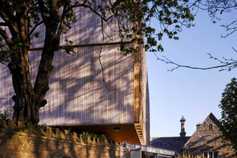Patrick Cahalan’s old house in Terryglass, Co Tipperary, has been uninhabited for a decade, but it has more character than most homes. Atop a vivid red dresser sits a myriad of plates and jugs, as well as old Saxa drums and a picture of the Sacred Heart of Jesus. In the corner, you can spot an antique radio and a mug ruck, the kind your granny had in her kitchen. A large open fire heats the room, filling it with the warm smell of turf.
The old house is in the yard of Barry and Lorraine Cahalan’s farm, where they run a sheep milking enterprise. Patrick was Barry’s granduncle, and lived the house until he died in 2005 at the age of 90.
The couple, who married in 2012, have a cheese business called Cáis na Tire and hope to renovate the house in the coming years.
“You’d never knock it down. It would be lovely to do it up and live in it,” says Barry. “Patrick kept everything. Even if he bought coleslaw in the shop he’d keep the tub and use it for nails.”
The house, as well as Patrick, was one of the subjects of two short films by local man Tony Donoghue, who is fascinated by the heritage of furniture in rural homes. A Film From My Parish was released in 2008 and told the story of six farmers from the locality.
His last film, Irish Folk Furniture, was released in 2012 and focuses on the furniture in a number of homes in the same area. Recorded in stop-motion, it follows the story of the restoration process and took almost three years to make.
Since its release, the charming film has captured the public’s imagination and has been shown at 270 film festivals and in 73 countries. It also won best animation at the Sundance Film Festival.
“The first time I came to Patrick’s house, he brought me to the other room to look at the English-style furniture. He couldn’t believe that I was interested in the other stuff,” says Tony. “Half the battle is convincing the people that what they have is gorgeous. When I made the film, I looked at 50 properties and they all had dressers. Some had tractor fittings and all sorts of things on them, but at least they were being used.”
Tony has made it his mission to convince people to restore their family furniture, and is even enlisting local children to survey the homes of older relations and neighbours.
“People like Patrick didn’t know what upcycling was. He would just go to someone and get them to fix his dresser, because it made sense,” says Tony. “My grandfather was a farmer and as far as I was concerned, everyone had a dresser handmade by their neighbours. You go to England and no one knows where their furniture came from. The rural dressers are not in houses anymore. They are in the offices of doctors and lawyers.
“That’s why I started the films. I wanted people to become interested in restoration. We’re at a crucial moment – we could lose all this history very quickly.”
John and Olivia Cahalan live two miles up the road from Barry and Lorraine’s farm, and were also featured in Tony’s film.
They restored a dresser – similar to the one in Patrick’s house – and a flour bin, which is now used by the couple’s four young children.
“We got advice from Tony and he said it could be done, we could restore the furniture. It was nice to do something, rather than let the pieces rot,” says John. “They bring a bit of history to the house.”
John’s father, Michael, grew up with the furniture and helped with the restoration. He’s glad to see the pieces put to use.
“It’s brilliant to see them use the furniture. The dresser is almost 100 years old and the flour bin was made in the 1950s. They were only gathering dust in a shed,” he says.
Tony thinks these pieces should be used, rather than kept as antiques.
“It becomes a part of living history then. So what if a child kicks a piece of a dresser, as long as it’s being used.”
Tony’s next project involves children interacting with the legends behind their culture, such as the Wren Boys. From furniture to farming, he believes that rural Ireland has a wealth of stories to tell.
“And it’s often the quiet person down the end of the lane.”






 This is a subscriber-only article
This is a subscriber-only article




























SHARING OPTIONS: